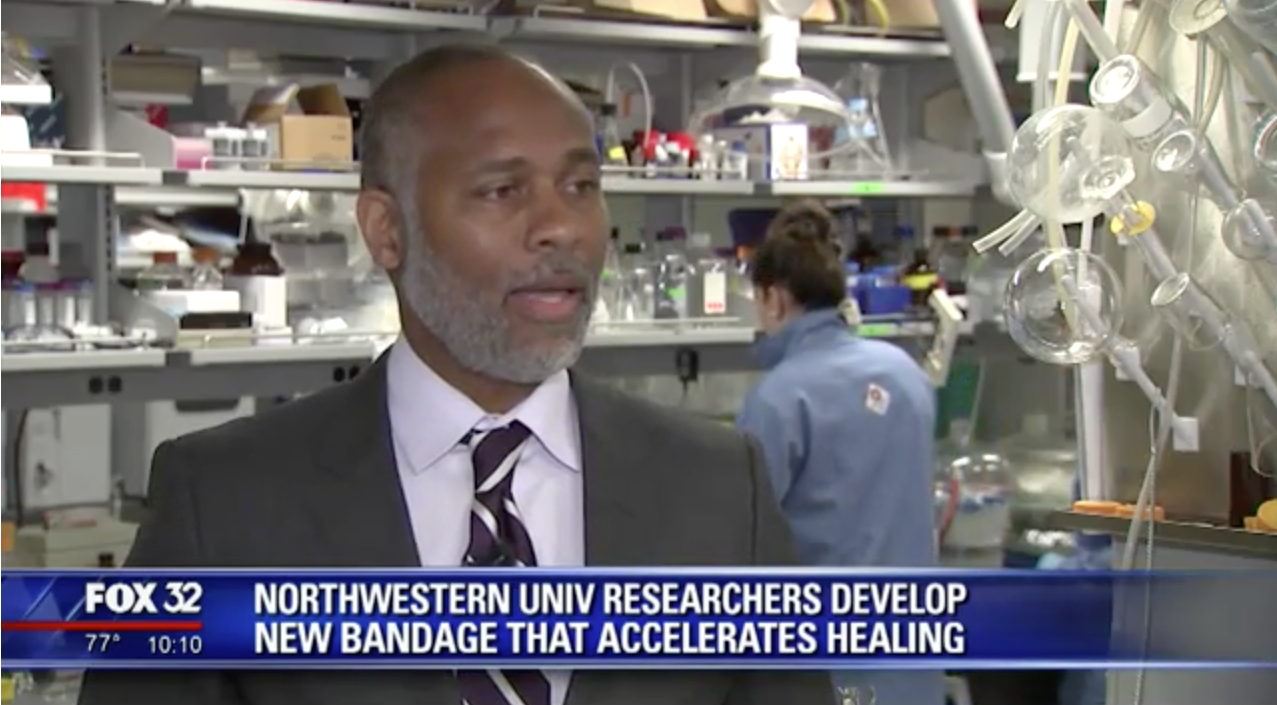September 17, 2018
A liquid bandage?
Developing new bandage with healing properties — Fox 32 Chicago News interview with CBC awardee, Guillermo Ameer, NU
Congratulations to Guillermo Ameer, NU, recently interviewed on Fox 32 Chicago News. The story covered a novel type of bandage developed in the Ameer lab, that has several unique properties. Originally the bandage is liquid but solidifies once applied to the wound, can cover any size and shape of a wound, and, perhaps most importantly, contains a wound-healing-substance — laminin — that stimulates tissue regeneration. The new bandage still awaits extensive clinical trials before reaching the market, but carries promise for those who suffer from hard-to-heal wounds, e.g. caused by diabetes. Ameer has many ties to CBC — he received a total of five CBC Awards in the past (see below). Ameer’s work on wound healing was also featured at the inaugural CBCAN meeting in 2017, as an example of a successful entrepreneurial initiative in academia.
Chicago researchers develop new bandage that accelerates healing
Fox 32 | by Sylvia Perez | August 16, 2018
Scientists at Northwestern University have developed a revolutionary new bandage.
They say it can dramatically accelerate the healing time for wounds and they’re hoping one day it’ll be a must-have item for medicine cabinets across the country.
A small lab at Northwestern University in Evanston has created a regenerative bandage that can teach the body to heal its own wounds without any drugs.
Guillermo Ameer and his staff of biomedical engineers originally developed the bandage to address non-healing diabetic foot ulcers — a problem that affects one in 7 diabetics. The bandage starts as a liquid, but when exposed to body temperature, it quickly solidifies into a gel. You can see it change right before your eyes.
The secret ingredient is a protein found in body tissue called Laminin. It encourages cells to gravitate and stick to one another and grow or regenerate. It also works as an antioxidant — reducing inflammation, warding off cell damage and conforms to any wound shape as they demonstrated for us on this pork roast.
Jaqueline Burke has diabetes. Helping other diabetics has become her passion. She’s a PHD student at Northwestern, working in Ameer’s lab.
“The solution could help heal wounds of all people. Wounds are very common and the quicker you can heal the better,” she said.
Another benefit is that replacing the bandage is as easy as rinsing it off with a saline spray.
Northwestern scientists are hoping this liquid bandage could be available in a few years and change the way we all deal with scrapes and cuts that are part of our everyday life.
The bandage faces more clinical testing and still needs FDA approval before it can hit the market.
Source:
Adapted (with modifications) from the Fox 32 Chicago by Sylvia Perez, published on August 16, 2018.
Featured scientist(s) with ties to cbc:
Guillermo Ameer, NU
- ▸ Inaugural CBCAN meeting (March 30, 2017):
Guillermo Ameer – Invited speaker - CBC Postdoctoral Research Award (2015):
▸ Synergistic Copper Metal-Organic Framework-Hydrogel Composite Improves Wound Healing
PIs: Josheng Xiaoand (postdoc) and Guillermo A. Ameer (NU) - CBC Postdoctoral Research Award (2014):
▸ Induced Pluripotent Stem Cells Derived Endothelial Cells in Vascular Tissue Engineering
PIs: Bin Jiang (postdoc), Guillermo A. Ameer and Jason A. Wertheim (NU) - CBC Postdoctoral Research Award (2014):
▸ Periadventitial delivery of retinoic acid via thermoresponsive hydrogel
PIs: Jian Yang (postdoc) and Guillermo A. Ameer (NU) - CBC Catalyst Award (2013):
▸ Craniofacial Tissue Engineering with Citric-Acid Based Nanocomposite Scaffolds
PIs: Russell R. Reid and Tong-Chuan He (UChicago), and Guillermo Ameer (NU) - CBC Business Plan Competition (2009):
Winner: VesselTek Biomedical, an innovative vascular products company started by Guillermo Ameer
▸ An NU Start-Up Wins 2009 CBC Business Plan Competition
Related:
June 18, 2018
▸ A wound-healing bandage
December 1, 2017
▸ Guillermo Ameer, NU bioengineer and CBC awardee, discusses the future of regenerative engineering
November 6, 2017
▸ Guillermo Ameer, NU bioengineer and CBC awardee, elected fellow of AIChE
April 7, 2017
▸ The CBC Accelerator Network (CBCAN) off to a great start!

